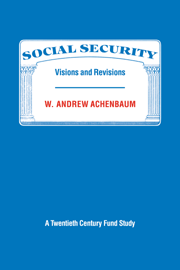Book contents
- Frontmatter
- Contents
- Dedication
- Foreword
- Acknowledgments
- Introduction
- Part I Social security comes of age
- 1 Social security: the early years
- 2 Social security matures, 1940–1972
- 3 The mid-life crisis of American social security
- 4 Social security gets a new lease on life
- Part II Current social security issues in historical perspective
- Notes
- Index
4 - Social security gets a new lease on life
Published online by Cambridge University Press: 04 August 2010
- Frontmatter
- Contents
- Dedication
- Foreword
- Acknowledgments
- Introduction
- Part I Social security comes of age
- 1 Social security: the early years
- 2 Social security matures, 1940–1972
- 3 The mid-life crisis of American social security
- 4 Social security gets a new lease on life
- Part II Current social security issues in historical perspective
- Notes
- Index
Summary
Social security's deteriorating short-term financial situation (the latest available Social Security Trustees' report indicated that by July 1983 there would not be adequate funds to pay old-age benefits) provided a powerful incentive for constructive action by the National Commission on Social Security Reform. The panel's composition, moreover, increased chances that Congress would take its recommendations seriously. The chairman, Alan Greenspan, and four others were appointed directly by the president; the Senate and House leaders designated five members each. The resulting balance – eight Republicans and seven Democrats – qualified as bipartisan, especially in view of the power lineup in Washington at the time. Seven of the fifteen (Representatives Bill Archer, Barber Conable, and Claude Pepper; Senators William Armstrong, Robert Dole, John Heinz, and Daniel Moynihan) were ranking members of congressional committees that dealt with social security matters or policies on aging. Former Representatives Martha Keys and Joe Waggoner still had influence on the Hill. Robert Ball and Robert Myers (the NCSSR executive director), of course, had been high-level social security officials for decades. Mary Falvey Fuller had served on the 1979 Social Security Advisory Council and had been a member of the Reagan transition team. Robert Beck, president of Prudential Life Insurance, and Lane Kirkland, president of the AFL-CIO, were the best-known experts for big business and labor on the subject.
- Type
- Chapter
- Information
- Social SecurityVisions and Revisions: A Twentieth Century Fund Study, pp. 81 - 100Publisher: Cambridge University PressPrint publication year: 1986



